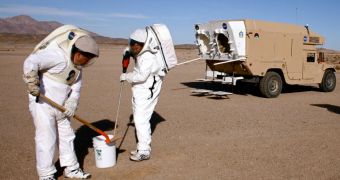As the goal of putting men on Mars is getting closer and closer, mankind is preparing for it the best way it can. Scientists from the United States recently took to the Mojave Desert, in order to complete a series of tests meant to improve future space exploration.
Astronauts deployed on the surface of the Red Planet will have to spend at least a month there, in order for their mission to justify itself. During this interval, they will have to get out of their lander several times, conducting experiments and exploring their surroundings.
However, the Martian environment will still be strange to them, even with all the data past NASA missions sent back of the landscape and its features. The purpose of the recent trek to the Mojave Desert was to augment these data with more practical results.
The work was led by a team of international researchers, which included experts from NASA, the Mars Institute and the Search for Extraterrestrial Intelligence (SETI) Institute. The simulation also included a rehearsal of how future astronauts will conduct geotechnical surveys on Mars.
These results may also be applied to missions going to the Moon or near-Earth asteroids, or even beyond. In fact, they are bound to be of great use regardless of the destination manned spaceflight missions take on.
The Mojave Desert was selected as a location for these tests because of its rough natural environment and the harshness of its conditions. The team included Honeybee Robotics, the Carnegie Mellon University and aerospace company Hamilton Sundstrand.
“Our overall goal was to learn how to scientifically explore and validate, as civil engineers would, open areas on the moon and Mars that might be candidate sites for an outpost or other elements of surface infrastructure,” Mars Institute chairman and field campaign leader Pascal Lee explains.
One of the most interesting devices that were analyzed during the investigation was the Gigapan Time Machine, a camera capable of snapping images at regular intervals. This will allow astronauts on another planet to keep long-term measurements of natural variability at their location.
The instrument is capable of producing high-resolution panoramas at short time intervals. These images will document human activities at and around the landing site, dust devils, clouds or any other natural phenomena that may occur in the neighborhood.
“The Mojave field test was an ideal opportunity to try out the camera before taking it to harsher environments such as the Arctic or Antarctica,” CMU Robotics Institute expert Randy Sargent explains.
“Field tests such as this one are a win-win for NASA, its partners, and the NTC,” adds the deputy chief of staff for operations and plans at the NTC, Cyle Fena. The NTC is the US Army’s National Training Center at Fort Irwin.
“They help broaden the training experience we offer our men and women in uniform, promote technical cross-fertilization in field operations, and ultimately allow all partners to meet their goals in more productive and cost-effective ways,” he concludes.

 14 DAY TRIAL //
14 DAY TRIAL //